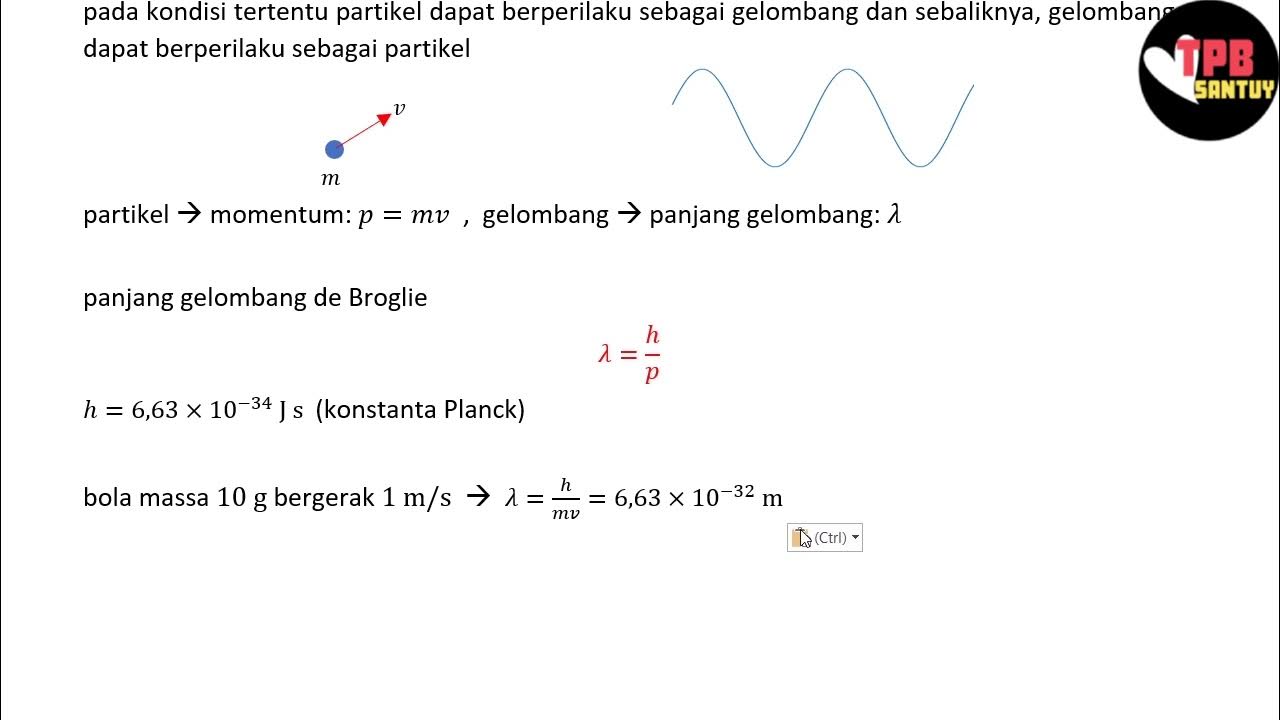Modul 5 Efek Fotolistrik
Summary
TLDRThis video script outlines a physics experiment on the photoelectric effect, where students observe the release of electrons from metal surfaces under electromagnetic waves. It covers the setup of the experiment, including the use of mercury lamps, photodiodes, and power supplies. The script details the steps of adjusting the wavelength, measuring current and stopping voltage, and performing various calculations. Theoretical comparisons are made with experimental results, emphasizing the relationship between wavelength, frequency, and stopping voltage. The video also discusses potential challenges and encourages deeper understanding of the underlying principles of the photoelectric effect.
Takeaways
- 😀 The photoelectric effect experiment involves measuring the emission of electrons from metal surfaces when exposed to electromagnetic waves.
- 😀 The setup for the experiment includes power supplies for the mercury lamp and other components, with connections to a photodiode and a distance setting of 35 cm between the lamp and photodiode.
- 😀 Before starting the experiment, the mercury lamp needs to warm up for 10 minutes to ensure proper functioning.
- 😀 Calibration of the current is necessary to set it to zero before proceeding with the experiment.
- 😀 The wavelength of the light source is adjusted to 365 nanometers at a diffraction grating spacing of 2 mm for the initial test.
- 😀 Once the light is activated, the current and stopping voltage are measured and recorded at various wavelengths, with the stopping voltage being adjusted until the current is zero.
- 😀 Variations in wavelength are explored, with values ranging from 365 nm to 577 nm to assess the effect on the current and voltage.
- 😀 Data for the frequency of the light is calculated using the formula f = speed of light / wavelength, based on known values of the speed of light.
- 😀 The experiment includes linear regression calculations to determine the Planck constant, with the data analysis involving comparing experimental results with theoretical predictions.
- 😀 A detailed analysis of the relationship between stopping voltage and frequency is performed, helping to confirm the linearity of the data and calculate the Planck constant.
- 😀 The use of a mercury lamp in the experiment is explained due to its specific emission spectrum, and common experimental challenges such as calibration errors and data variability are discussed.
Q & A
What is the main focus of the experiment described in the script?
-The main focus of the experiment is the photoelectric effect, which explores the phenomenon of electrons being ejected from a metal surface when exposed to electromagnetic waves.
What equipment is used in this experiment?
-The experiment uses a Dayak-type power supply, a mercury lamp, a photodiode, and a few cables. The setup also includes a voltage supply and measurement instruments for current and voltage.
What is the first step in setting up the experiment?
-The first step is to connect the power supplies to the circuit. This includes wiring the power supplies to the mercury lamp and photodiode.
Why do you need to wait 10 minutes after turning on the mercury lamp?
-The 10-minute wait is necessary for the mercury lamp to warm up and stabilize before measurements are taken.
How is the current calibrated during the experiment?
-The current is calibrated by setting it to zero before taking any measurements. This is done using the display and ensuring the current reads zero.
What is the significance of adjusting the wavelength of the light in the experiment?
-The wavelength of the light is adjusted to observe how it affects the photoelectric effect. By varying the wavelength, the relationship between the light's energy and the emission of electrons can be studied.
What is meant by 'stopping voltage' in the experiment?
-The stopping voltage is the voltage required to stop the flow of emitted electrons, essentially reducing the current to zero. It helps in determining the work function of the metal surface.
What formula is used to calculate the frequency of the light in the experiment?
-The frequency is calculated using the formula: f = c / λ, where 'c' is the speed of light and 'λ' is the wavelength of the light.
What is the purpose of performing linear regression in the experiment?
-Linear regression is used to analyze the relationship between the stopping voltage and the frequency of the light, which helps to calculate Planck's constant and verify theoretical predictions.
Why is mercury used as the light source in this experiment?
-Mercury is used because it emits light with specific wavelengths that are ideal for studying the photoelectric effect. The wavelengths of mercury's emission lines match the energies needed to excite electrons from metal surfaces.
What challenges or issues might arise during the experiment?
-Challenges could include difficulty in accurately measuring the stopping voltage, variations in the mercury lamp's intensity, or errors in calibration. These factors can affect the precision of the results.
Outlines

此内容仅限付费用户访问。 请升级后访问。
立即升级Mindmap

此内容仅限付费用户访问。 请升级后访问。
立即升级Keywords

此内容仅限付费用户访问。 请升级后访问。
立即升级Highlights

此内容仅限付费用户访问。 请升级后访问。
立即升级Transcripts

此内容仅限付费用户访问。 请升级后访问。
立即升级浏览更多相关视频

Dual Nature of Radiation & Matter in 10 mins 😱🔥 Ch 11 Physics Class 12 Boards 2022-23 Score 95+

7. ELETRÔNICA - Painel Solar

Albert Einstein and The Photoelectric Effect | AMS OpenMind

Photoelectric Effect Theory Lesson

Physics - Photoelectric effect

Dualisme Gelombang-Partikel | Fenomena Kuantum | Part 1 | Fisika Dasar
5.0 / 5 (0 votes)
